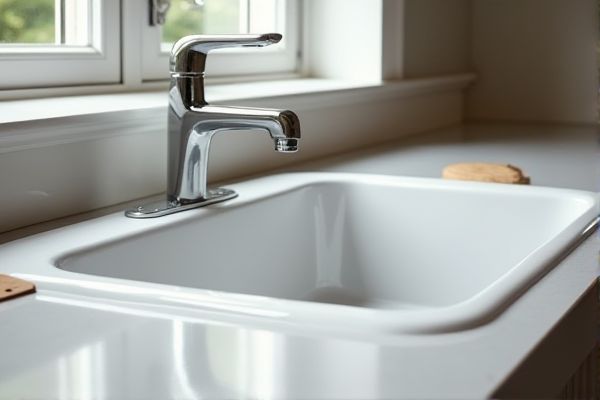
A sink with a scrub board offers enhanced functionality for hand-washing clothes and scrubbing dishes, providing a textured surface that makes cleaning more efficient. Discover the key differences and which option best suits your needs by reading the rest of the article.
Table of Comparison
| Feature | Sink with Scrub Board | Smooth Sink |
|---|---|---|
| Surface Texture | Textured, includes scrub board | Flat, smooth surface |
| Primary Use | Washing clothes, scrubbing stains | General washing, rinsing dishes |
| Cleaning Efficiency | Enhanced for tough dirt and stains | Standard cleaning, less effective for scrubbing |
| Material | Often stainless steel or ceramic with ridged board | Steel, ceramic, or composite with smooth finish |
| Maintenance | Requires regular cleaning of scrub board grooves | Easy to clean and maintain |
| Installation | Typically bulkier due to scrub board | Compact and streamlined design |
| Use Case | Ideal for heavy-duty washing in laundry areas | Best for kitchen or utility sinks without scrubbing needs |
| Cost | Generally higher due to added features | Often more affordable |
Introduction: Comparing Sink Types
A sink with a scrub board offers textured surfaces designed for thorough cleaning, making it ideal for tackling tough stains and scrubbing pots or vegetables. In contrast, a smooth sink provides a sleek, easy-to-clean surface that resists grime buildup and simplifies daily maintenance. Choosing between these options depends on your kitchen habits and preference for either deep cleaning efficiency or streamlined upkeep.
What Is a Scrub Board Sink?
A scrub board sink features ridged surfaces that enhance scrubbing efficiency for dishes and laundry, making it ideal for heavy-duty cleaning tasks. Unlike smooth sinks, the textured scrub board helps remove stubborn grime by providing friction, reducing the need for extra tools or harsh chemicals. These sinks are commonly found in utility rooms and kitchens where thorough manual cleaning is essential.
Features of a Smooth Sink
A smooth sink features a seamless surface that is easy to clean and resistant to grime buildup, making it ideal for maintaining hygiene in kitchens. Its sleek design allows water and debris to flow smoothly toward the drain, reducing the risk of clogs and enhancing overall functionality. Unlike sinks with scrub boards, smooth sinks offer a minimalist aesthetic that complements modern kitchen styles while requiring less maintenance.
Cleaning Efficiency: Scrub Board vs. Smooth
A sink with a scrub board enhances cleaning efficiency by providing a textured surface ideal for scrubbing stubborn stains and stuck-on food, reducing the need for excessive scrubbing tools. Smooth sinks offer easier rinsing and quick removal of debris but may require additional brushes or sponges for thorough cleaning. The scrub board's abrasive surface accelerates grime removal, making it preferable for heavy-duty kitchen tasks.
Durability and Longevity
A sink with a scrub board typically offers enhanced durability due to its textured surface, which resists scratches and wear from abrasive cleaning tools better than smooth sinks. Smooth sinks, often made from stainless steel or porcelain, provide a sleek appearance but may show signs of wear and minor damage more quickly over time. Your choice depends on the balance between durability needs and aesthetic preferences, with scrub board sinks excelling in longevity under heavy use.
Maintenance and Upkeep
Sinks with scrub boards require more frequent cleaning to prevent soap scum and grime buildup in the textured surface, demanding regular scrubbing to maintain hygiene. Smooth sinks offer easier maintenance with fewer crevices, allowing quick wiping and less effort to keep them spotless. Both types benefit from routine care, but smooth sinks generally reduce time spent on upkeep due to their flat, non-porous design.
Aesthetic Appeal and Design Choices
Sinks with scrub boards offer a rustic, vintage aesthetic that complements farmhouse and traditional kitchen designs, adding textured visual interest and functional charm. Smooth sinks present a sleek, modern appearance that enhances minimalist and contemporary spaces through clean lines and smooth surfaces. Selecting between a scrub board and smooth sink depends on the desired kitchen style and the balance between decorative appeal and practical usability.
Cost Differences
Sinks with scrub boards typically cost 15-25% more than smooth sinks due to the added material and manufacturing complexity. Smooth sinks generally have lower prices and simpler installations, making them more budget-friendly for basic kitchen setups. The extra expense of a scrub board sink is often justified by its added functionality for washing and scrubbing tasks.
Best Use Cases for Each Sink Type
Sinks with scrub boards excel in heavy-duty cleaning tasks, making them ideal for washing vegetables, scrubbing pots, and removing tough stains due to their textured surface that enhances friction. Smooth sinks are better suited for general kitchen use and delicate items, as their sleek surface prevents damage to fragile dishes and simplifies cleaning dirt and debris. Choosing between these sink types depends on whether the primary need prioritizes intensive scrubbing efficiency or gentle cleaning and ease of maintenance.
Choosing the Right Sink for Your Needs
Choosing the right sink depends on your kitchen activities and cleaning preferences; a sink with a scrub board offers built-in abrasive support for scrubbing pots and pans, ideal for heavy-duty cleaning tasks. A smooth sink provides a sleek, easy-to-clean surface that suits modern aesthetics and simple maintenance. Evaluating your washing habits and kitchen design ensures selecting a sink that balances functionality and style effectively.
 homyna.com
homyna.com